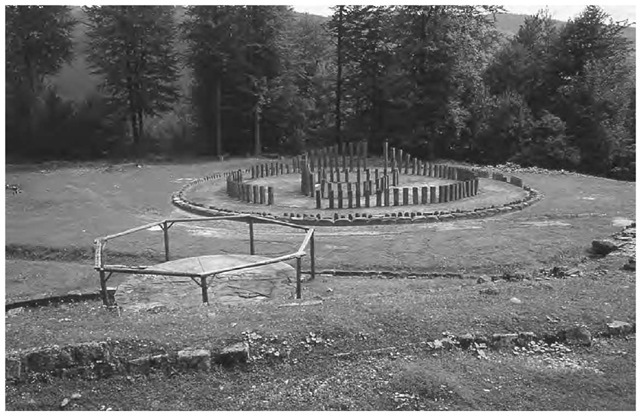The Carpathian mountains run through northwest Romania in a wide arc, enclosing an area that stretches down westwards into the Carpathian basin in Hungary. This region forms modern-day Transylvania, but in the centuries immediately before and after the birth of Christ it was home to the Dacians, a powerful kingdom whose later resistance to the Roman conquest is famously depicted in Trajan’s Column in Rome. The rugged landscape to the south of the modern town of Ora^tie contains a number of impressive Dacian monuments, including settlements, stone-built fortresses and “sanctuaries,” assumed to have been places of religious worship. It is in this area, at an elevation of over 1,000 meters (3,300 feet), that one encounters Sarmizegetusa Regia, the ancient capital of the Dacians.
Sarmizegetusa Regia contained a citadel and living areas with dwellings and workshops, but it also contained a sacred zone. A number of rectangular temples were located there, the bases of their supporting columns still visible in regular arrays. Perhaps the most enigmatic construction at the site, however, is the large circular sanctuary. This comprised a “D”-shaped setting of timber posts surrounded by a timber circle, which was surrounded in turn by a low stone kerb. The original timber posts have long since rotted away, and the ones currently visible on the site are modern reconstructions in the original postholes. They help the modern visitor visualize the layout of the original construction, although the heights of the posts is completely speculative.
The layout of the timber settings bears a broad resemblance to the sarsen stone monument at Stonehenge in England, where five trilithons laid out in a horseshoe shape are surrounded by a complete circle. This has led some people to proclaim Sarmizegetusa Regia as a “Romanian Stonehenge” and to propose it as an ancient observatory comparable in importance to the British site. In fact, this logic is flawed on several grounds. First, the two sites are culturally unrelated and well separated in time: Sarmizegetusa Regia was not built until 1,500 years after Stonehenge had fallen into disuse. The importance of the Romanian sanctuary must be measured in the context of the Dacian cultural heritage. Second, Stonehenge is no longer considered by serious scholars to have been an ancient observatory. Its main axis was certainly aligned toward the solstices, and the same has been claimed of the large circular sanctuary. But in fact there are problems. The Romanian “horseshoe” (if one excludes the straight side of the “D”) faces southeast rather than northeast as at Stonehenge, so it is the midwinter rather than midsummer sunrise upon which it is claimed to be aligned. This would be the direction of sunrise on the shortest day of the year if there were a distant, level horizon in this direction. But there is not. The horizon altitude in this direction is several degrees, and the midwinter sunrise would occur over ten degrees farther south.
The large sanctuary at Sarmizegetusa Regia, Romania, with the “Andesite Sun” in the foreground.
Yet the circular sanctuary and other structures in the sacred zone may well have had astronomical or calendrical associations. It has been suggested, for example, that a large circular block of stone 1.5 meters (five feet) in diameter, laid flat and known popularly as the “Andesite Sun,” was used as a sundial. It has been suggested that a circle of rectangular grooves cut into the stone might have been used to mark the length of the shadow from a central gnomon, but the existence of such a gnomon is pure speculation. Others have argued that the stone was simply used for sacrifices or other rituals. Yet the idea of as sundial is far from absurd, since there are known to have been influences on Dacian culture from Hellenistic Greece, and these may well have included ideas about geometry and astronomy.

